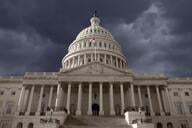You have /5 articles left.
Sign up for a free account or log in.
As presidents of two public community colleges, serving a combined 82,000 students in Maryland and Pennsylvania, we are concerned about news that the U.S. Department of Health and Human Services is drafting policies that eliminate the concept of transgender persons.
It is easy to imagine how transgender students could face circumstances that require some adaptation by colleges that have been traditionally designed for just two genders. The ability of transgender students to attend school and engage in learning may be constrained by institutions that refuse to make such accommodations. It is the responsibility of the U.S. Department of Education to protect such students so that they may engage in the learning that will shape their future potential. Transgender students must be considered a protected category in order that any lapses in their access might be reported to the Education Department’s Office for Civil Rights. As President Trump and other members of his administration consider eliminating these protections, we would like to share some insights from our professional and personal experiences.
While our leadership of two colleges informs much of our perspective, we also share a personal investment: each of us is married to a partner of the same gender.
President Pollard lives openly with her wife and their child in Maryland, while President “Ski” and his husband live openly in Pennsylvania. We both belong to LGBTQ Presidents in Higher Education, a group that advocates for the rights of LGBTQ people. And each of us served on a panel of LGBTQ presidents at the 2018 American Association of Community Colleges’ annual meeting in Dallas.
Choosing to live openly has been a decision that each of us has found empowering. But it has also exposed us to the words and actions of people who condemn our lives and are sometimes painfully outspoken about it. Perhaps because of this, it is a bit easier for us to imagine how a transgender student facing discrimination or hostility at school could choose to withdraw socially or academically, or even leave school without a degree. Such choices limit a student’s future opportunity and diminish our society’s communal potential -- troubling impacts on several levels.
Community colleges already serve people who are vulnerable in other ways: immigrants, displaced workers, low-income people and, disproportionately, people of color. We have both witnessed firsthand how policies -- and even subtle attitudes -- that make people feel unwelcome can hamper their academic progress.
In some cases people are driven to leave school; in other cases they are not as successful as they could have been because they don’t reach out for academic assistance or friendships that could have eased their journeys. When any aspect of a person’s identity is rejected in a public way, the instinct is to pull back. At public institutions like ours, that means pulling away from education -- a result that no one can afford in today’s economy. Our campuses actively counter such dynamics by intentionally welcoming all people. We also are diligent about creating policies that embrace all students -- a process we like to call radical inclusion.
A recent study by the Centers for Disease Control found that 27 percent of transgender students report feeling unsafe at or going to school. The protection of transgender students should not be a difficult question. There is a powerful precedent for such inclusive protections in 20th-century education law: Brown v. Board of Education, Title VI and Title IX, among others. Each of these instances codified the protection of people who were considered somehow “different” from the majority by the norms of their days: people of color, people with disabilities and women. Their formal legal protection was ultimately the force that mandated that public schools include them. While some schools had already done this before legal requirements, for those that resisted, such laws advanced truly equal access in all parts of the nation.
Ultimately, the reluctance of some schools to protect transgender students is about fear. It’s a fear of difference, of the unknown and of other questions that could arise if we acknowledge gender identity to be something more complex than a simple binary. Certain rigid binaries were rattled when new groups of people first enrolled widely in public schools and colleges: women, people of color and people with disabilities, among others. The times when they were not considered fully human, and thus, not legally and morally deserving of access, were not so long ago. Once everyone acknowledges the full humanity of transgender students, the addition of single-use restrooms or locker rooms will seem like the small accommodations that they truly are. Until then, these students need the equal protection that comes from the law.
As leaders of colleges, each of us is determined that nothing should stand in the way of the fundamental mission of education -- not poverty, not gender, not race or national origin, not legal status, sexuality or gender identity. In some eras the Education Department has demonstrated leadership that opened the doors of schools and colleges to more people -- a veritable force for equality and opportunity in our nation. In that context, we urge Betsy DeVos, the U.S. secretary of education, to examine carefully the impact that the removal of legal protections could have on transgender students’ access to education. Such changes could not only diminish individual lives, but the very legacy of the department itself.




